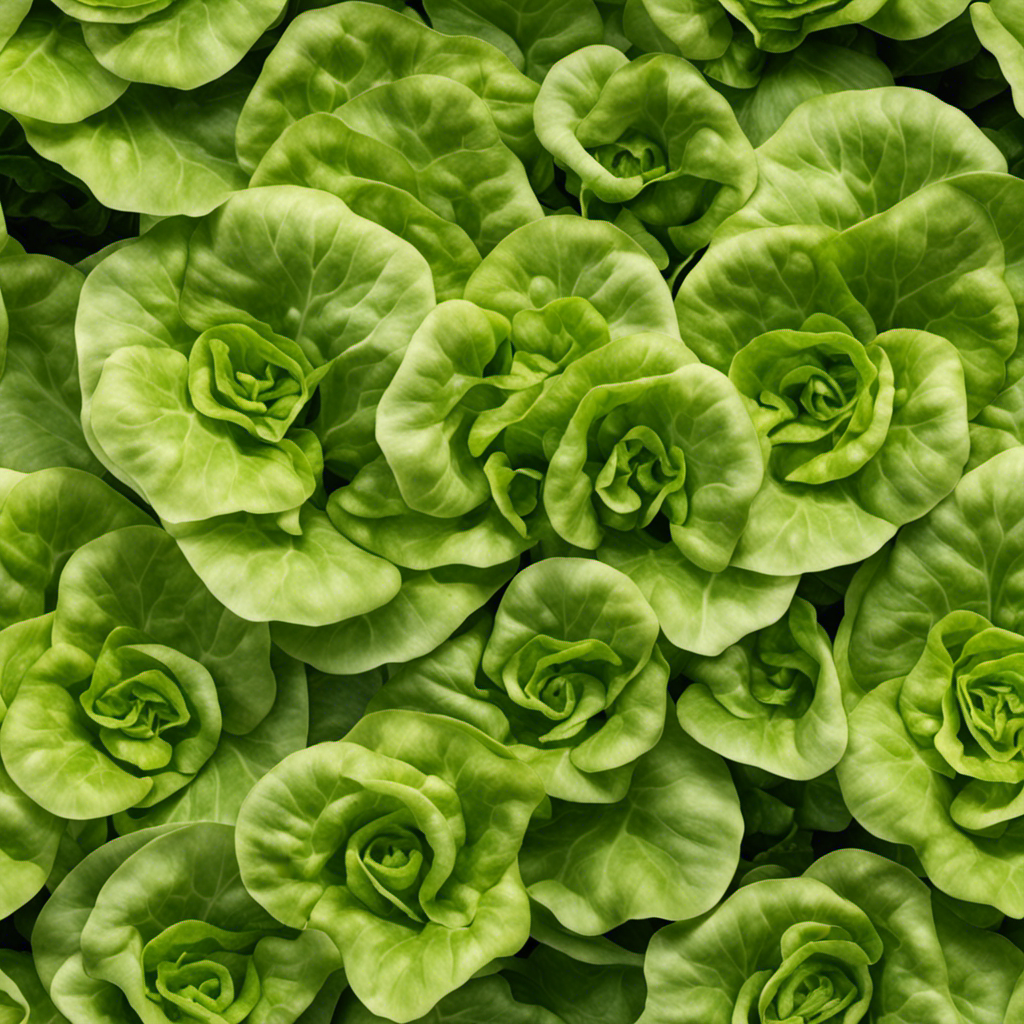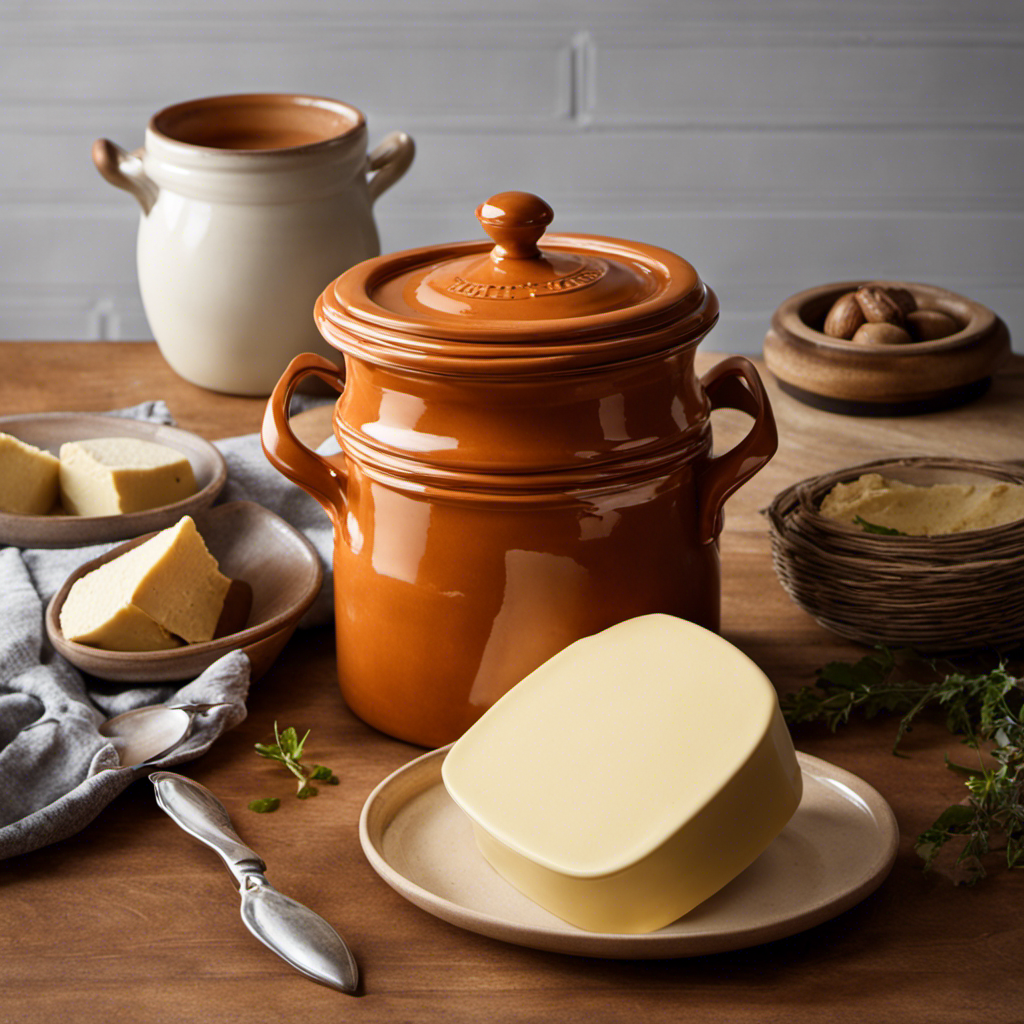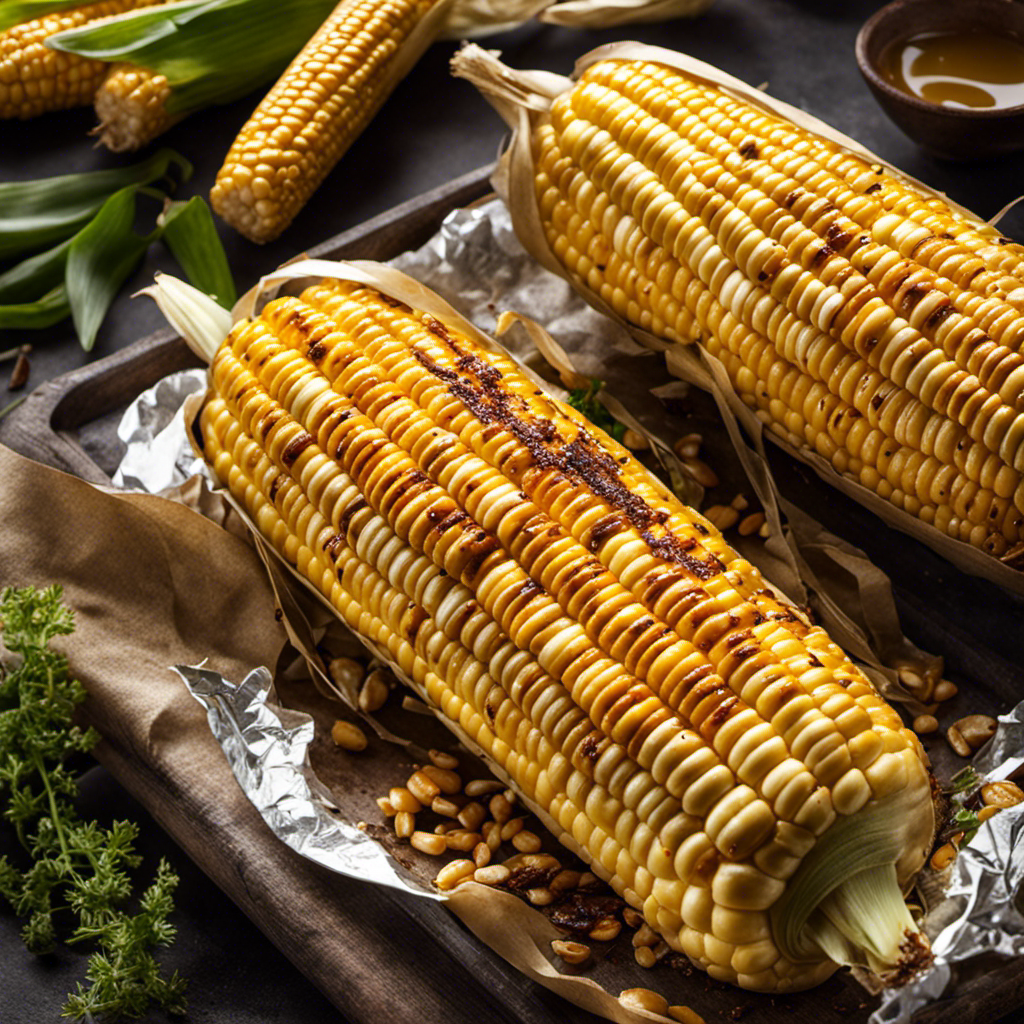Did you know that the term ‘butter lettuce’ comes from its smooth and velvety texture ? Yes, it does!
Butter lettuce, also known as Bibb or Boston lettuce, has a rich, buttery taste that makes it a favorite among salad enthusiasts.
In this article, I will explore the origins, characteristics, and culinary uses of butter lettuce.
Join me on this journey as we delve into the world of this delightful leafy green and discover why it has earned its deliciously fitting name.
Key Takeaways
- The name ‘butter lettuce’ comes from its smooth, velvety texture resembling butter.
- Butter lettuce has been cherished throughout history for its tender leaves and versatility.
- Butter lettuce is commonly used as a base for salads due to its tender leaves and mild flavor.
- Butter lettuce is known for its tender leaves and mild flavor.
The Origins of Butter Lettuce
You might be wondering where butter lettuce actually comes from. Well, let me enlighten you about its origins.
Butter lettuce, also known as Bibb lettuce or Boston lettuce, has a rich history dating back to ancient times. Its name originates from its smooth, velvety texture, which resembles the consistency of butter. This tender and delicate leafy green originates from the Mediterranean region, where it was cultivated by the ancient Egyptians and Greeks.
Historical references indicate that butter lettuce was highly prized by the Roman elite, who believed it possessed medicinal properties. Over time, it spread to other parts of Europe, eventually making its way to North America in the 19th century.
Today, butter lettuce is a popular choice for salads due to its mild flavor and soft, buttery leaves.
Historical References to Butter Lettuce
When exploring the origins of butter lettuce and its culinary uses throughout history, it is fascinating to delve into the rich tapestry of this delicate and flavorful leafy green.
The name ‘butter lettuce’ itself hints at its smooth and velvety texture, reminiscent of butter melting on the tongue.
From ancient civilizations to modern gastronomy, butter lettuce has been cherished for its tender leaves and versatility in salads, sandwiches, and even cooked dishes.
Let’s embark on a journey to uncover the intriguing origins and culinary evolution of this beloved lettuce variety.
Origins of Butter Lettuce
The origins of butter lettuce can be traced back to the Mediterranean region. Historical references suggest that it was cultivated in ancient Egypt and Greece thousands of years ago. The name ‘butter lettuce’ is believed to have originated from its tender and velvety leaves, which have a smooth texture similar to butter.
This type of lettuce is known for its mild and slightly sweet flavor, making it a popular choice in salads and sandwiches. Over time, butter lettuce spread to different parts of the world and became a staple in many cuisines. Today, it is widely grown and enjoyed for its delicate leaves and versatility in various dishes.
Its origins and historical references highlight the long-standing popularity of butter lettuce and its significance in culinary traditions.
Culinary Uses Throughout History
Culinary enthusiasts have long enjoyed the versatile and delicate leaves of butter lettuce in various dishes throughout history. Its culinary evolution and cultural significance are undeniable.
Here are four notable uses of butter lettuce:
-
Salads: Butter lettuce’s tender leaves make it the perfect base for salads. Its mild flavor pairs well with a wide range of ingredients, creating refreshing and vibrant salads.
-
Wraps: The large, flexible leaves of butter lettuce are often used as a healthier alternative to tortillas or bread in wraps. They provide a crisp and refreshing texture to any filling.
-
Lettuce cups: Butter lettuce leaves can be used as cups to hold a variety of fillings, such as ground meat, vegetables, or rice. This popular dish, commonly known as ‘lettuce wraps,’ is a staple in many Asian cuisines.
-
Garnish: Butter lettuce leaves are often used as an attractive garnish for various dishes. Its bright green color and delicate appearance add a touch of elegance to any plate.
The culinary evolution of butter lettuce and its cultural significance can be seen through its diverse uses in different cuisines around the world.
Characteristics and Appearance of Butter Lettuce
Butter lettuce is known for its tender leaves and mild flavor. Its characteristics and appearance make it a favorite among salad lovers. The leaves of butter lettuce are soft and smooth, with a delicate texture that practically melts in your mouth. The color of the leaves can range from light green to pale yellow, giving it a beautiful and appetizing appearance. One of the benefits of butter lettuce is its high water content, which helps to keep you hydrated. It is also a good source of vitamins A and K, as well as folate and potassium. Additionally, butter lettuce is low in calories, making it a healthy choice for those watching their weight.
| Characteristic | Description |
|---|---|
| Leaf Texture | Soft and smooth |
| Leaf Color | Light green to pale yellow |
| Water Content | High water content, helps with hydration |
| Nutritional Value | Good source of vitamins A and K, folate, and potassium |
| Caloric Content | Low in calories, suitable for weight management |
| Flavor | Mild, delicate taste |
Culinary Uses for Butter Lettuce
One popular way to enjoy butter lettuce is in a refreshing salad with a variety of vegetables and a tangy dressing. Here are four delicious recipes that showcase the versatility of butter lettuce in salads:
-
Strawberry and Goat Cheese Salad: Toss butter lettuce with sliced strawberries, crumbled goat cheese, and candied pecans. Drizzle with a balsamic vinaigrette for a sweet and savory combination.
-
Asian-Inspired Chicken Salad: Top butter lettuce with grilled chicken, mandarin oranges, sliced almonds, and crispy wonton strips. Finish with a sesame ginger dressing for an Asian twist.
-
Mediterranean Salad: Combine butter lettuce with cherry tomatoes, cucumber, kalamata olives, and feta cheese. Dress with a lemon herb vinaigrette for a light and refreshing Mediterranean flavor.
-
BLT Salad: Crisp bacon, juicy tomatoes, and creamy avocado are the perfect toppings for butter lettuce. Add a tangy buttermilk ranch dressing for a classic flavor combination.
These recipes highlight the fresh and delicate nature of butter lettuce, making it the perfect base for a variety of salads.
Nutritional Benefits of Butter Lettuce
When it comes to eating healthy, lettuce is often at the top of the list. Not only is it low in calories and high in fiber, but it also packs a punch when it comes to vitamins and minerals.
Lettuce is particularly rich in vitamins A, C, and K, which are essential for maintaining healthy skin, boosting the immune system, and promoting bone health.
Vitamin Content in Lettuce
You’ll be pleased to know that butter lettuce is packed with essential vitamins. Here is a breakdown of the vitamin content in this nutritious leafy green:
-
Vitamin A: Butter lettuce is rich in vitamin A, which is essential for healthy vision, immune function, and cell growth.
-
Vitamin K: This lettuce variety is a great source of vitamin K, which plays a crucial role in blood clotting and maintaining strong bones.
-
Vitamin C: Butter lettuce contains vitamin C, an antioxidant that helps protect against cell damage and supports a healthy immune system.
-
Vitamin E: This vitamin is present in butter lettuce and helps protect cells from oxidative stress, promoting overall health.
With its impressive vitamin content, incorporating butter lettuce into your diet can offer numerous health benefits, including improved vision, enhanced immune function, and better bone health.
Health Benefits of Lettuce
Now that we know about the vitamin content in lettuce, let’s talk about the health benefits of this leafy green.
Lettuce is not only low in calories but also packed with essential nutrients that can contribute to overall health and well-being. It is a great source of dietary fiber, which aids in digestion and helps maintain a healthy weight. Additionally, lettuce is rich in antioxidants, such as vitamin C and beta-carotene, which can help protect the body against free radicals and reduce the risk of chronic diseases.
There are many creative ways to incorporate lettuce into your diet. You can use it as a base for salads, add it to sandwiches or wraps, or even use it as a topping for tacos or burgers.
To ensure that lettuce retains its nutritional value, proper farming techniques are essential. Lettuce requires well-drained soil, adequate sunlight, and regular watering. Farmers also need to pay attention to pest control and disease prevention to ensure a healthy crop.
In the next section, we will explore another nutrient-rich leafy green and its benefits.
Nutrient-Rich Leafy Green
If you’re looking for a nutrient-rich leafy green to add to your diet, spinach is an excellent choice. Here are four reasons why spinach is a powerhouse of nutritional properties:
-
High in vitamins and minerals: Spinach is packed with vitamins A, C, and K, as well as folate and iron. These nutrients are essential for maintaining healthy bones, skin, and immune function.
-
Antioxidant-rich: Spinach is loaded with antioxidants that help protect your body against damage from harmful free radicals. These antioxidants can help reduce the risk of chronic diseases, including heart disease and certain types of cancer.
-
Low in calories: Spinach is a low-calorie food, making it a great addition to any weight loss or maintenance plan. It is also high in fiber, which can help promote feelings of fullness and aid in digestion.
-
Versatile and delicious: Spinach can be enjoyed in a variety of ways, from salads to sautés to smoothies. Its mild flavor and tender texture make it a versatile ingredient in many recipes.
Incorporating spinach into your diet is a simple and delicious way to boost your intake of essential nutrients. Whether you enjoy it in a salad or cooked in a stir-fry, spinach is a nutritious addition to any meal.
Varieties and Cultivation of Butter Lettuce
There are several varieties of butter lettuce that you can cultivate in your garden. Butter lettuce, also known as Bibb or Boston lettuce, is a popular leafy green that is prized for its tender, buttery leaves and mild flavor. Some common varieties include Buttercrunch, Tom Thumb, and Little Gem.
Each variety has its own unique characteristics, such as size, shape, and color. When it comes to cultivation, butter lettuce prefers cooler temperatures and partial shade. It requires well-drained soil and regular watering to keep the leaves crisp and tender. It can be grown from seeds or transplants, and it’s important to thin the plants to allow proper air circulation.
With the right care and attention, you can enjoy a bountiful harvest of fresh, delicious butter lettuce from your own garden.
Frequently Asked Questions
How Many Calories Does Butter Lettuce Have?
Butter lettuce has low calories, making it a healthy choice. It is also packed with nutritional benefits like vitamins A and K. Incorporating it into your diet can contribute to overall health and well-being.
Can Butter Lettuce Be Used in Smoothies?
Sure, butter lettuce can be used in smoothies! It adds a subtle, buttery flavor and a refreshing crunch. Plus, it’s packed with nutrients like vitamins A and K. Check out some delicious butter lettuce smoothie recipes for a healthy boost!
What Are Some Common Recipes That Use Butter Lettuce?
There are many common recipes that use butter lettuce, such as salads with various toppings and dressings. It is one of the different types of lettuce that is often used in salads.
How Long Does It Take for Butter Lettuce to Grow?
Growing butter lettuce can be a delightful experience. The ideal growing conditions include cool temperatures and well-drained soil. Harvesting techniques involve cutting the leaves close to the base, ensuring a fresh and crisp taste.
Is Butter Lettuce a Good Source of Vitamins and Minerals?
Butter lettuce is a good source of vitamins and minerals, making it a beneficial addition to your diet. To maximize freshness, store it properly in the refrigerator. Incorporating butter lettuce into your meals can have numerous health benefits.
Conclusion
In conclusion, butter lettuce is a delectable addition to any meal. Its rich history and delightful characteristics make it a standout choice. Its origins can be traced back to ancient times, where it gained recognition for its buttery texture and delicate flavor. This versatile leafy green is not only visually appealing but also packed with essential nutrients. Whether used as a base for salads or as a crunchy wrap, butter lettuce adds a touch of elegance to any dish. So next time you’re in the mood for a culinary adventure, don’t forget to savor the succulent, sensational butter lettuce!










